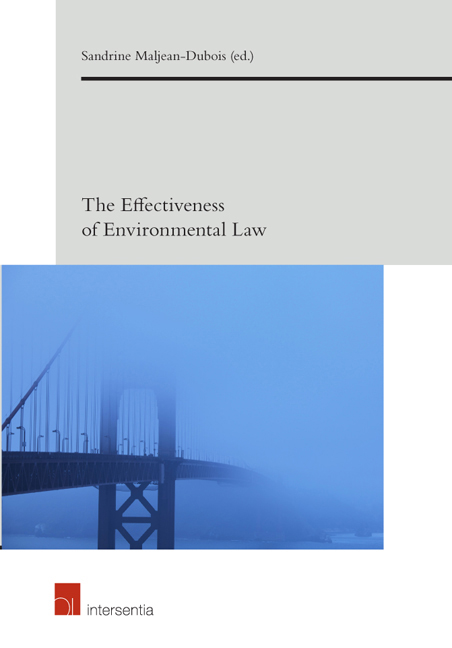Book contents
- Frontmatter
- Preface
- Contents
- Introduction. The Effectiveness of Environmental Law: A Key Topic
- Part 1 Measuring and Assessing Effectiveness
- Part 2 Improving Effectiveness
- Better Legislation
- Chapter 2 The Effectiveness of Payment for Ecosystem Services: a mix between a gradient model of public intervention and an effective normative framework
- Chapter 3 The Effectiveness of Environmental Law through Contracts
- Chapter 4 Legal Weaknesses and Windows of Opportunity in Transnational Biodiversity Protection: as Seen through the Lens of an Ecosystem Approach-Based Paradigm
- Chapter 5 Better Expertise through Institutional Linkages. The Case of the Mediterranean Basin
- Chapter 6 Environmental Dignity Rights
- Chapter 7 The Environmental Protection of Traditional Knowledge and the Active Participation of Indigenous Peoples in the Planning, Management and Decision-Making Processes as Means of Improving the Effectiveness of Environmental Law
- Chapter 8 Promoting Electricity from Renewable Energy Sources in France. Is French Law Appropriate for Achieving the Objectives?
- Chapter 9 Changing Patterns of International Environmental Law-Making: Addressing Normative Ineffectiveness
- Chapter 10 The Effectiveness of EU Nature Legislation: a long battle to secure supporting sectoral policies
- Better Implementation
Chapter 4 - Legal Weaknesses and Windows of Opportunity in Transnational Biodiversity Protection: as Seen through the Lens of an Ecosystem Approach-Based Paradigm
from Better Legislation
Published online by Cambridge University Press: 27 September 2018
- Frontmatter
- Preface
- Contents
- Introduction. The Effectiveness of Environmental Law: A Key Topic
- Part 1 Measuring and Assessing Effectiveness
- Part 2 Improving Effectiveness
- Better Legislation
- Chapter 2 The Effectiveness of Payment for Ecosystem Services: a mix between a gradient model of public intervention and an effective normative framework
- Chapter 3 The Effectiveness of Environmental Law through Contracts
- Chapter 4 Legal Weaknesses and Windows of Opportunity in Transnational Biodiversity Protection: as Seen through the Lens of an Ecosystem Approach-Based Paradigm
- Chapter 5 Better Expertise through Institutional Linkages. The Case of the Mediterranean Basin
- Chapter 6 Environmental Dignity Rights
- Chapter 7 The Environmental Protection of Traditional Knowledge and the Active Participation of Indigenous Peoples in the Planning, Management and Decision-Making Processes as Means of Improving the Effectiveness of Environmental Law
- Chapter 8 Promoting Electricity from Renewable Energy Sources in France. Is French Law Appropriate for Achieving the Objectives?
- Chapter 9 Changing Patterns of International Environmental Law-Making: Addressing Normative Ineffectiveness
- Chapter 10 The Effectiveness of EU Nature Legislation: a long battle to secure supporting sectoral policies
- Better Implementation
Summary
ABSTRACT
This chapter reflects upon the weaknesses of transnational environmental law to protect biodiversity – stemming from fragmentation and anthropocentrism. The study employs an ecosystem approach-based paradigm as a perspective of legal research, given that it seeks to overcome the fragmentation of natural resources law and the rigidity of a legal decision-making structure, which arguably reflect the old semantics of the environment as merely a set of resources to be consumed. These features of the contemporary legal architecture are illmatched with the socio-ecological realities and, thereby, are predisposed to environmental degradation. I propose that the fragmentation and rigidity of law could be mitigated through the adoption of an ecosystem approach-based framework in law via further integration and adaptation. From a transnational law perspective, the integration of biodiversity drivers are perhaps best facilitated through institutional linkages in and between regimes, and through contractual arrangements. The adaptation, on the other hand, could arguably be fostered via the operationalization of the precautionary principle on lower governance levels through adaptive law methods and processes.
INTRODUCTION
Biodiversity has an intrinsic value, but since it can also have an indirect impact on internationally acknowledged human rights, it is also no less than vital from an anthropocentric perspective to protect biodiversity. Despite several multilateral environmental agreement regimes dedicated wholly or primarily to tackling aspects of biodiversity loss, human activity keeps causing massive extinctions to biodiversity and biodiversity loss continues to occur at an unacceptably high rate. Arguably, one major reason why the regulatory attempts have failed in halting biodiversity loss is the contemporary positive regulatory structure, which was originally built on anthropocentric premises to exploit and commodify nature. Consequently, the laws to protect interconnected and uncertain environmental matters have been formulated under a sectorbased, rigorous approach taking technical data into account – without a full understanding of the environmental problematic and of ecology. From the perspective of biodiversity, this means that there are many other laws than just those specifically known as “biodiversity laws” whose goal achievement is essentially connected to biodiversity preservation. Therefore, this artificial fragmentation oft en leads to inefficiencies and problem-shift ing. Additionally, contemporary ecological understanding emphasizes constant transformations in – and various inter-linkages and interdependencies between – ecosystems, whereupon the rigid, front-end built laws show significant inconsistency with their object.
- Type
- Chapter
- Information
- The Effectiveness of Environmental Law , pp. 81 - 100Publisher: IntersentiaPrint publication year: 2017
- 1
- Cited by

